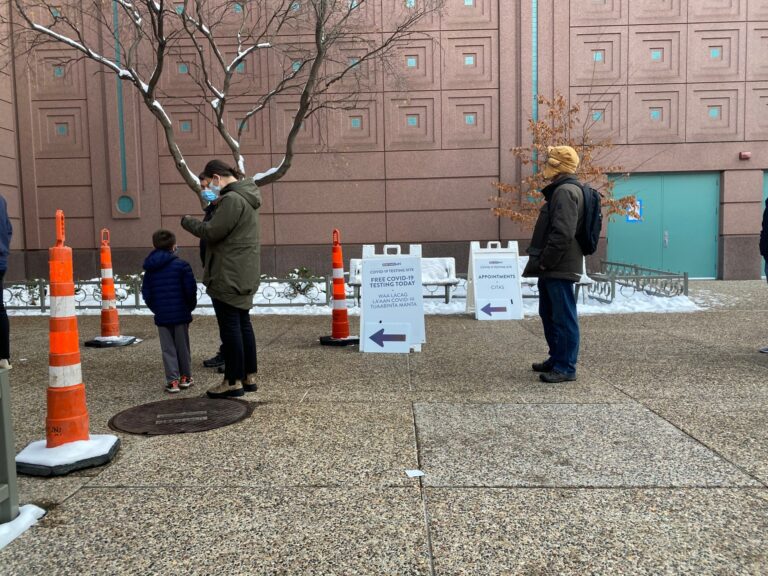Minneapolis, Minnesota – On Saturday afternoon, Torey Van Oot visited the recently opened COVID-19 Saliva Testing Center at Minneapolis-Saint Paul International Airport.
After following well-marked free parking directions, the Minneapolis resident arrived at a station, bordered by Plexiglas, where she spat into a cup while surrounded by fellow residents who did the same.
“The whole car-to-car experience was 47 minutes,” Van Oot told Al Jazeera. He received his test results via email at 12am on Monday.
The airport test site opened Nov. 12, the same day Minnesota launched statewide saliva test at home following a 24-province pilot last month. So far, more than 50,000 tests have been sent to homes in the Twin Cities metro area alone.
The blitz test, in partnership with Vault Health, a New York-based men's health company, is an effort to curb the rapid spread of the coronavirus, which has exploded in the Midwest in recent weeks.
“We are at a dangerous point in this pandemic. As many of you have seen, it is raging throughout the Midwest and this nation. We're seeing infection rates in the state around Minnesota that are the highest on the planet,” Minnesota Gov. Tim Walsh said at a news conference Wednesday.
The governor has announced a series of new measures designed to slow transmission, including halting indoor dining at bars and restaurants and closing gyms and fitness facilities.
The Minnesota Department of Health on Wednesday reported 5,102 new cases of COVID-19 and a record 67 deaths. According to data from Johns Hopkins University, the state recorded 47,268 cases in the previous seven days.

Political divisions
The recent spike in cases comes amid ongoing partisan battles in the state legislature over the response to the outbreak.
Republican officials, including state Rep. Matt Grossell and state Senate Majority Leader Paul Gazelka — who announced a diagnosis of COVID-19 on Sunday – are outspoken in their criticism of Walz's use of emergency powers to manage the pandemic from the start.
Despite internal resistance, Minnesota launched what Vault founder Jason Feldman describes as “a full-scale assault on COVID at every level” with its extensive testing efforts mobilized in just seven weeks.
But the state is surrounded by others with worse COVID-19 situations than its own — so much so that it has begun allowing Wisconsin and North Dakota residents to be tested at Minnesota locations near the border.
While much of the Midwest, particularly North and South Dakota, avoided major outbreaks earlier this year, experts fear the recent spikes suggest the states' lackluster approach to containing COVID-19 has caught up with them.
Between Sept. 1 and Nov. 18, Wisconsin's positivity rate rose from a 9.2 percent seven-day average to 33.1 percent. Iowa has recorded one Test positivity rate of 22.1 percent the last 14 days.
In North and South Dakota, the situation is even more dire. As of Sept. 1, North Dakota had about 1,900 active positive cases. As of November 18, there were 10,131 active positive cases. As of Thursday in South Dakota, there were 17,884 positive cases representing 26% of the 68,671 total cases the state has seen to date.

“It's the culmination of months of inaction,” Dr Jeremy Youde, a global health policy expert and dean of the College of Liberal Arts at the University of Minnesota, Duluth, told Al Jazeera. “States where we are seeing large outbreaks in the Midwest have delayed or refused to take steps that Fauci and the CDC have recommended.”
Youde explained that public health issues are “viewed through a partisan lens.”
In addition to the lack of mask mandates and social restrictions to mitigate the spread, there was also active pushback when attempts were made. Jere Fabick, board member and adviser to the conservative think-tank Heartland Institute; sued Wisconsin Gov. Tony Evers after trying to require mask use statewide last month.
South Dakota remains off limits, a position Republican Gov. Christy Noem has held since the outbreak began.
North Dakota Republican Governor Doug Burgum and State Health Officer Dirk Wilke announced North Dakota's first COVID-19 mitigation requirements (PDF) on November 13, three days after Burgum announced on November 9 that the state was at 100 percent hospital capacity.
These included 50 percent capacity in bars and restaurants, 25 percent capacity in event venues and wearing face coverings in indoor businesses and public spaces as well as outdoors where social distancing is not possible. The mask mandate is unenforced, expires on December 13 and excludes religious services.

Burgum and Wilke also took an unusual step to try to address the state's lack of hospital capacity: allowing health care workers with asymptomatic cases of COVID-19 to continue working in hospitals and nursing homes (PDF).
The announcement surprised Tessa Johnson, president of the North Dakota Nurses Association, and her team. “It was a gut punch for us because we didn't have any discussion with him,” he said.
Johnson told Al Jazeera that she loves her job and her team, and that if she was asked to work while positive, she would probably do it if no one else was available to do it. Others worry that if they don't continue to show up for work while sick, the decision could be held against them in the future.
But without federal relief and a national mitigation strategy, waiting for a vaccine — unlikely to be widely available before 2021 — is the most likely solution to the upper Midwest's battle with COVID.
For Johnson, North Dakota got into this situation “because our elected officials didn't listen to the science. They haven't made tough decisions soon enough.”
Johnson concluded: “People keep saying it's taking away personal liberties, but at the end of the day there's no accountability and guess which communities want to pick up the pieces? Nurses.”

